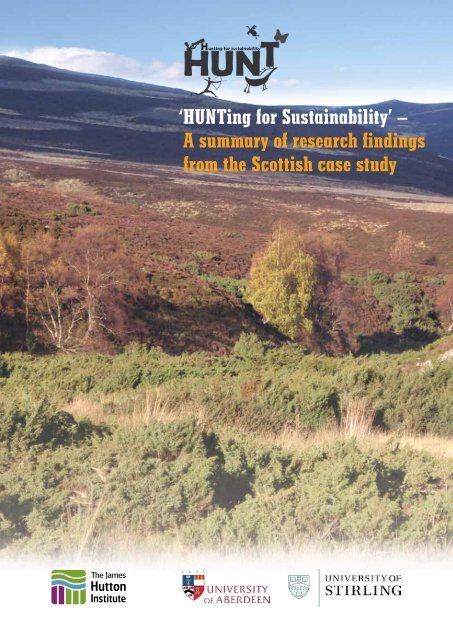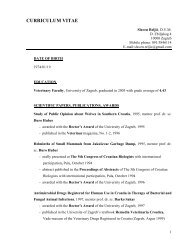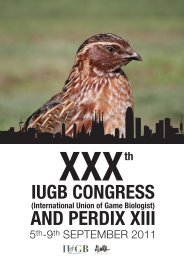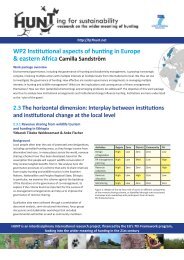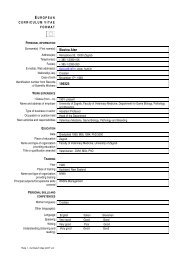A summary of research findings from the Scottish case study
A summary of research findings from the Scottish case study
A summary of research findings from the Scottish case study
You also want an ePaper? Increase the reach of your titles
YUMPU automatically turns print PDFs into web optimized ePapers that Google loves.
CONTENTS1 On <strong>the</strong> meanings <strong>of</strong> shooting andstalking for hunters and non-hunters 42 Large scale policy changes and <strong>the</strong>ir impactson sporting and game management discourses 63 Developing a ‘new vision’ for deer management:‘From species management to an ecosystemapproach’ 834 Governance and game bird shooting styles 105 A review <strong>of</strong> <strong>the</strong> effects <strong>of</strong> game birdmanagement on non-target species 126 The same but different: Upland managementand bird diversity in <strong>the</strong> <strong>Scottish</strong> Highlands 137 Public preferences for moorland managementon sporting estates 168 What do hunters and o<strong>the</strong>r recreational users<strong>of</strong> moorlands want? 179 Managing <strong>the</strong> uplands for multiple benefits 18Front cover image:© Francisco Bisi
© Nils Bunnefeld4On <strong>the</strong> meanings <strong>of</strong> shooting andstalking for hunters and non-huntersAnke FischerBackgroundIn Scotland, shooting, stalking and <strong>the</strong> associated land management practices arecurrently subject to a public debate over <strong>the</strong> ‘right’ way to manage <strong>the</strong> countryside.Such debates are <strong>of</strong>ten addressed <strong>from</strong> economic and ecological angles, neglectingwhat fieldsports actually mean to people – both to those who are actively engaged instalking or shooting, and those who are not. Our <strong>research</strong> aimed to investigate <strong>the</strong>semeanings, not only in Scotland, but also in four o<strong>the</strong>r European and two easternAfrican countries.Research questions• What does hunting (shooting, stalking) mean to those who hunt andthose who do not?• How do people argue to support <strong>the</strong>ir views on (different types <strong>of</strong>) hunting?
MethodWe used <strong>the</strong> same qualitative methods across <strong>study</strong> sites in all sevencountries. This included focus group discussions and interviews with(a) people who hunt, (b) people who do not hunt and (c) people knownto have anti-hunting views. In Scotland, 37 individuals participatedin <strong>the</strong> <strong>study</strong>, including 19 who are involved in stalking or shooting.The overall sample size across all countries was 364. The data wereanalysed in a grounded fashion, that is, no <strong>the</strong>ories or conceptswere a priori imposed on <strong>the</strong> data. For <strong>the</strong> final steps <strong>of</strong> ourinterpretation, we used discourse analysis to examine how recurrentpatterns in <strong>the</strong> debate are used to shape people’s ways <strong>of</strong> thinkingabout hunting.materialtrophycommercialrurallivelihoodsfoodHunting motivestaking care <strong>of</strong>natureimmaterialrecreationculturalhuman instinctFig.: Overview <strong>of</strong> motives for huntingdiscussed by <strong>study</strong> participants in 7 countriesto ei<strong>the</strong>r legitimise or delegitimise huntingKey <strong>findings</strong>• In all seven countries and across all three groups <strong>of</strong> participants (“hunters”,“non-hunters”, “anti-hunters”), discussions tended to be differentiated,distinguishing between types <strong>of</strong> hunting ra<strong>the</strong>r than talking about huntingper se.• Without prompting, many participants across all groups paid a lot <strong>of</strong> attentionto <strong>the</strong>ir perceptions <strong>of</strong> <strong>the</strong> legitimacy <strong>of</strong> hunting. They tended to distinguishbetween acceptable and unacceptable hunting based on three types <strong>of</strong> criteria:(i) characteristics <strong>of</strong> <strong>the</strong> animal hunted, (ii) <strong>the</strong> technique used to hunt and(iii) <strong>the</strong> motives <strong>of</strong> <strong>the</strong> hunter.• Across all groups, <strong>the</strong>se arguments resembled each o<strong>the</strong>r. For example, manyhunters and non-hunters in Scotland argued that shooting and stalking wasabsolutely acceptable if <strong>the</strong> game meat was eaten, but unacceptable if <strong>the</strong> carcasseswere discarded.• Motives for hunting tended to be regarded as legitimate if <strong>the</strong>y were considered‘moderate’ or ‘under control’, but <strong>the</strong> same motive would be evaluated asillegitimate if it was considered ‘excessive’ or out <strong>of</strong> control. For example,fieldsports for recreational purposes might be regarded as legitimate where<strong>the</strong> hunters’ motive was <strong>the</strong> enjoyment <strong>of</strong> nature, but widely seen as unacceptablewhere <strong>the</strong> motive was suspected to be an “adrenaline rush” or “thrill”. Similarly,game management was seen as positive where it took care <strong>of</strong> nature in aconsiderate and moderate way – where it was seen as exaggerated interferencewith nature, or as “playing god”, it was regarded as unacceptable.❝I think <strong>the</strong> o<strong>the</strong>r thingwhich is really importantto remember is that <strong>the</strong> vastmajority <strong>of</strong> <strong>the</strong> people thatare working <strong>the</strong> estates arenot doing it for <strong>the</strong> money.They do it because it is a way<strong>of</strong> life, and it is part <strong>of</strong> <strong>the</strong>irculture and heritage …When or if <strong>the</strong> sportinginterest deteriorates or startsto fade away in parts<strong>of</strong> Scotland, part <strong>of</strong>our heritage will be lost❞(Stalker, in his thirties)5Lessons learnt for best practice• Perceptions <strong>of</strong> <strong>the</strong> legitimacy <strong>of</strong> different types <strong>of</strong> hunting are an importantpart <strong>of</strong> discourses over game management, and should thus be made moreexplicit in <strong>the</strong> public debate.• Especially in Scotland, many people involved in fieldsports and non-huntersmight share more similar views than popularly portrayed.• These commonalities could be used as a starting point for ‘education on <strong>the</strong>countryside’ that is <strong>of</strong>ten called for by game managers.❝Killing something forfood seems reasonable.Killing something forpopulation controlseems reasonable.Killing something forfun just doesn’t seemright to me.❞(Non-hunter, in his forties)(De-)legitimising hunting – discourses over <strong>the</strong> morality <strong>of</strong> hunting in Europe and eastern Africa,Fischer, A., Kereži, V., Arroyo, B., Mateos-Delibes, M., Tadie, D., Lowassa, A., Krange, O. andSkogen, K. [Manuscript in Preparation]
© Anke Fischer6Large scale policy changes and<strong>the</strong>ir impacts on sporting and gamemanagement discoursesLiz Dinnie and Anke FischerBackgroundA large part <strong>of</strong> <strong>the</strong> <strong>Scottish</strong> countryside is traditionally managed for shooting andstalking. However, recent policy changes at both national and European levels reflectan increasing diversity <strong>of</strong> both public and private land management objectives. Thishas resulted in <strong>the</strong> creation <strong>of</strong> new formal institutions (i.e. rules) governing landand game management, and <strong>the</strong> inclusion <strong>of</strong> actors <strong>from</strong> both <strong>the</strong> public sector andNGOs who have previously not had much say in countryside matters.Research questions• What is <strong>the</strong> interplay between traditional and newly emerging institutionsgoverning game management?• How do game managers respond to <strong>the</strong>se policy changes?
© Scott Newey8Developing a ‘new vision’ for deermanagement: ‘From species managementto an ecosystem approach’Annie McKee, Liz Dinnie and Justin IrvineBackgroundThis <strong>research</strong> was prompted by recent and ongoing policy and institutional reform inScotland surrounding <strong>the</strong> sustainable management <strong>of</strong> all deer species. This includes<strong>the</strong> merger <strong>of</strong> <strong>the</strong> Deer Commission for Scotland and <strong>Scottish</strong> Natural Heritage,<strong>the</strong> passage <strong>of</strong> <strong>the</strong> Wildlife and Natural Environment (Scotland) Act 2011 (WANE),<strong>the</strong> continuing importance <strong>of</strong> ‘Wild Deer: a National Approach’ and Best PracticeGuidance, as well as likely implications <strong>of</strong> <strong>the</strong> Land Use Strategy and forthcomingCAP reforms. These policy changes reflect an increasing diversity <strong>of</strong> both public andprivate land management objectives. However, opinions are divided on <strong>the</strong> necessityfor formal institutional change (including new regulatory frameworks) to ensurecompeting objectives are balanced effectively.Research questions• To identify and discuss <strong>the</strong> uncertainties <strong>of</strong> institutional change that influencessustainable deer management and all actors involved;• To develop governance scenarios for future deer management; and• To suggest principles and strategies that should be considered by policy-makersand o<strong>the</strong>r interests, when deer and wider natural resource policy is developed.
MethodWe posed <strong>the</strong>se <strong>research</strong> questions through a series <strong>of</strong> ‘scenario workshops’(see Figure 1). Similar workshops were held in o<strong>the</strong>r HUNT partner countries.The <strong>Scottish</strong> workshops were attended by representatives <strong>of</strong> a range <strong>of</strong> national levelmember organisations and public agencies with an interest in deer management,field sports and conservation. A set <strong>of</strong> ‘future history’ style scenarios wereco-constructed by <strong>the</strong> stakeholder group and <strong>research</strong> team, and through an analysis<strong>of</strong> <strong>the</strong> strengths, weaknesses, opportunities and threats <strong>of</strong> each scenario, formed<strong>the</strong> basis for <strong>the</strong> identification <strong>of</strong> future policy strategies.Stage (i)Evaluating <strong>the</strong>current policyissuesStage (ii)Identifying <strong>the</strong>key factors andincertaintiesScenariosco-constructionStage (iii)Exploringgovernanceoptions andevaluatingscenariosStage (iv)Highlightingpolicy relevanceand futurestrategiesFigure 1: Stages in <strong>the</strong> scenario workshop methodKey <strong>findings</strong>• Participants agreed that deer management must be considered in <strong>the</strong> context<strong>of</strong> wider species and ecosystem scale objectives, alongside socio-economicimplications.• Effective policy development needs to promote collaboration between publicand private interests to deliver wider public benefits.• Policies need to promote conflict resolution processes and balance effectivevoluntary approaches with regulatory enforcement where appropriate.• Managing natural resources (including deer) on a more holistic, ecosystem scale,needs to be based on <strong>research</strong> recommendations, recognising <strong>the</strong> full range <strong>of</strong>ecosystem values and functions.9Lessons learnt for best practice• The scenario workshops highlight <strong>the</strong> potential to learn <strong>from</strong> o<strong>the</strong>r species andhabitat management frameworks, for example district fishery boards. Lessons mayalso be learned internationally <strong>from</strong> developments in <strong>the</strong> integrated management<strong>of</strong> natural resources, such as in Sweden.• There is a need for land management stakeholder involvement in <strong>the</strong>co-construction <strong>of</strong> <strong>research</strong> agendas with <strong>research</strong>ers and policy makers, todevelop understanding <strong>of</strong> <strong>the</strong> practicalities <strong>of</strong> <strong>the</strong> ‘ecosystem approach’.• Cross-partner comparison <strong>of</strong> <strong>the</strong> scenario workshop approach illustrates <strong>the</strong> needfor methodological flexibility and adaptation to ensure stakeholder relevance andmaximise ownership <strong>of</strong> <strong>research</strong> process and output. Future processes that engagestakeholder groups in <strong>the</strong> ‘active’ <strong>research</strong> process will seek to ensure that <strong>the</strong>focus, method and output are best designed to meet <strong>the</strong> needs <strong>of</strong> stakeholders,as well as producing innovative scientific and policy-relevant <strong>findings</strong>.For fur<strong>the</strong>r information, please see:HUNT project and National Stakeholder Group (2011) Developing a New Vision for Deer Management: ‘From species management to ecosystemapproach’ – Policy implications <strong>of</strong> current thinking. The James Hutton Institute, June 2011.Available online at: http://fp7hunt.net/Portals/HUNT/Publikasjoner/developing%20a%20new%20vision%20for%20deer%20management.pdf
© Nils Bunnefeld10Governance and game bird shootingstylesScott Newey, Karen Mustin, Steve Redpath and Justin IrvineBackgroundAll forms <strong>of</strong> hunting are deeply cultural activities and <strong>the</strong>re are many regional andnational hunting styles. While environment, habitat, species biology and economicsdictate many aspects <strong>of</strong> hunting styles, <strong>the</strong>se critically interact with <strong>the</strong> well knownbut <strong>of</strong>ten unexplored facets <strong>of</strong> land tenure and hunting rights. Here we look at howland tenure and <strong>the</strong> provision <strong>of</strong> hunting rights and regulations influences huntingstyles and focus on game bird shooting in Europe and North America as an example.Research questionsThe aim <strong>of</strong> <strong>the</strong> present <strong>study</strong> is to review hunting styles in Europe and NorthAmerica, and to compare <strong>the</strong>se styles to those adopted in <strong>the</strong> UK and explore how<strong>the</strong>se interact with governance and land tenure.
© Scott NeweyA review <strong>of</strong> <strong>the</strong> effects <strong>of</strong> game birdmanagement on non-game species’Scott Newey, Karen Mustin, Steve Redpath and Justin Irvine12BackgroundAcross Europe, game bird hunting occurs over millions <strong>of</strong>hectares <strong>of</strong> land, and provides economic and social benefits.Game birds and <strong>the</strong>ir habitat are <strong>of</strong>ten intensely managedto increase population density. Here we set out to assess <strong>the</strong>consequences for non-target species.Research questionsAll management activities can have positive and negativeeffects on certain species. We reviewed <strong>the</strong> literature to assess<strong>the</strong> evidence for <strong>the</strong> effects <strong>of</strong> different types <strong>of</strong> managementon o<strong>the</strong>r species also present in <strong>the</strong> habitats managed forgame birds.MethodWe considered five broad management activities: predatorcontrol, habitat management, provision <strong>of</strong> supplementaryfood and water, rear and release, and parasite/diseasecontrol and reviewed published literature to collate andsyn<strong>the</strong>sise our current understanding <strong>of</strong> <strong>the</strong> impacts <strong>of</strong> <strong>the</strong>semanagement activities on <strong>the</strong> abundance, diversity, breedingsuccess and survival <strong>of</strong> non-game species. We reviewed 41studies.Key <strong>findings</strong>The published evidence suggests that game bird managementcan have positive effects on some non-game species andnegative effects on o<strong>the</strong>rs. Predator control is one <strong>of</strong> <strong>the</strong> mostwell studied aspects <strong>of</strong> game bird management results mainlyshow positive or no significant effect on non-game species.However, illegal control <strong>of</strong> protected predators has clearnegative effects on some predator populations. Habitatmanagement in agricultural areas generally has positiveeffects on a range <strong>of</strong> species, while <strong>the</strong> effects <strong>of</strong> managementin non-agricultural areas are more variable. Whilst <strong>the</strong>re area number <strong>of</strong> negative effects <strong>of</strong> rear and release, <strong>the</strong>re is little<strong>research</strong> concerning how this form <strong>of</strong> management affects<strong>the</strong> abundance, diversity, breeding success and survival <strong>of</strong>non-game species. While some aspects <strong>of</strong> <strong>the</strong> effects <strong>of</strong> gamebird management on non-game species are well studiedo<strong>the</strong>r areas are less well <strong>research</strong>ed, in particular <strong>the</strong>re is littleknown on <strong>the</strong> effects <strong>of</strong> <strong>the</strong> provision <strong>of</strong> supplemental foodand water, and studies to assess <strong>the</strong> impacts <strong>of</strong> parasite anddisease control on non-game wildlife are generally lacking.Lessons learnt for best practiceDespite many shared goals, hunting and conservation are<strong>of</strong>ten in real or perceived conflict over management objectivesand practices. Although more data are clearly needed to fullyunderstand <strong>the</strong> broader biodiversity effects and trade-<strong>of</strong>fsassociated with different management activities, <strong>the</strong> availableevidence suggests that, with <strong>the</strong> exception <strong>of</strong> illegal predatorcontrol and release <strong>of</strong> exotic species, game bird managementpractices are positive or benign for non-game species.Two birds with one stone: can biodiversity conservation and game bird management be reconciled? Mustin, K., Arroyo, B., Beja, P., Bro, E., Irvine, R.J.,Newey, S. & Redpath, S. [Manuscript in preparation].
© Adam SmithThe same but different:Upland management and birddiversity in <strong>the</strong> <strong>Scottish</strong> HighlandsScott Newey, Karen Mustin, Ros Bryce, Debbie Fielding,Steve Redpath and Justin Irvine13BackgroundThe protection <strong>of</strong> biodiversity is a key national and international policy objective.While protected areas provide one approach, <strong>the</strong> majority <strong>of</strong> land lies outside<strong>of</strong> protected areas and is subject to different, and <strong>of</strong>ten multiple, land uses.Understanding how biodiversity can be maximised amongst <strong>the</strong> varied pressures<strong>of</strong> o<strong>the</strong>r forms <strong>of</strong> land use is important for evaluating <strong>the</strong> effects <strong>of</strong> different policyobjectives.Research questionsHow do different forms <strong>of</strong> upland management objectives and practices influencebird diversity and community composition?MethodHea<strong>the</strong>r moorland on twenty six upland estates with a variety <strong>of</strong> differentmanagement objectives was surveyed for breeding birds in spring-summer 2010.On each estate two to four 1km 2 areas were surveyed using a modified version <strong>of</strong><strong>the</strong> Breeding Bird Survey methodology, where each 1km 2 area was traversed by2 parallel 1km long transects spaced 500m apart. Each 1km 2 area was surveyedtwice, once in April–May and again in May–June. All birds directly associated with<strong>the</strong> survey area were identified and recorded. Survey data were used to estimate birdspecies diversity using <strong>the</strong> Shannon Index. We also used (Non-metric Multi-dimensionalScaling) ordination to explore patterns in bird community composition andstructure. For each estate we asked for information on <strong>the</strong> dominant managementobjectives and predator control. We used satellite imagery to estimate <strong>the</strong> percentage<strong>of</strong> land in each survey area which was subject to muirburn. Finally, we used <strong>the</strong> LandClassification 2007 data to estimate habitat diversity for each estate.
Key <strong>findings</strong>After controlling for <strong>the</strong> effect <strong>of</strong> latitude and longitude, none <strong>of</strong> <strong>the</strong> managementobjectives nor activities analysed in this <strong>study</strong> had a significant effect on bird diversity(Red grouse production; F 1,23=1.56, p=0.23, Red deer stalking; F 1,23=0.35, p=0.56,Sheep production; F 1,23=0.57, p=0.45, Biodiversity conservation; F 1,23=0.95, p=0.34,Predator control; F 1,23=0.35, p=0.56, Percentage muirburn; F 1,23=0.52, p=0.48,Estate habitat diversity; F 1,23=2.12, p=0.16).However, <strong>the</strong> composition <strong>of</strong> upland bird communities was significantly affected by<strong>the</strong> main management activity (Figure 1). For example, wader species were associatedwith red grouse production and muirburn. Management for sheep production, predatorcontrol and estate habitat diversity had no significant effect on <strong>the</strong> diversity orcomposition <strong>of</strong> upland bird communities in this <strong>study</strong> (Table 1).Lessons learnt for best practiceThe management objectives and activities examined in this <strong>study</strong> do not appear toeffect upland bird diversity per se, but do appear to effect community composition.Therefore, bird diversity may be maximised by a landscape with diverse landmanagement strategies.14© Scott Newey © Lucy Gilbert
15Figure 1NMDS ordination plot showing 95% centroids for estates managed for grouse production (Grouse Yes) and those estates not managedfor grouse production (Grouse No). Those species that are within or close to <strong>the</strong> centroids tend to be more strongly associated with thatparticular management objective.Names in green are wader species. Names in red is red grouse.In all 58 bird species were recorded during surveys, however for clarity only 21 species are shown in this figure.Key to species: species names are shortened to <strong>the</strong> first 4 letters <strong>of</strong> <strong>the</strong> genus and <strong>the</strong> first 4 letters <strong>of</strong> <strong>the</strong> species name;Lagolago – Red grouse, Tetrtetr – Black grouse, Anthprat – Meadow pipit, Alauarve – Skylark, Saxirube - Winchat, Saxitorq – Stonechat,Phyltroc – Willow warbler, Acroscho – Sedge warbler, Cardflav – Twite, Locunaev – Grasshopper warbler, Phylcoll – Chiffchaff,Hirurust – Swallow, Numearqu – Curlew, Pluvapri – Golden plover, Alialpi – Dunlin, Vanevane – Lapwing, Trinnebu – Greenshank,Gallgall – Common snipe, Haemostr – Oystercatcher, Actihypo – Common sandpiper, Cucucano – Cuckoo, Falcpere – Peregrine,Falctinn – Kestrel, Falccolu – Merlin, Butebute – Buzzard, Circcyan – Hen harrier, Asi<strong>of</strong>lam – Short-eared owl, Aquichry – Golden eagle,Cinccinc – Dipper, Lagomutu – Ptarmigan.Variables that had a significant effect oncommunity structureVariables that did not have a significant effect oncommunity structureEasting (r2 = 0.34, p < 0.01) Northing (r2=0.08, p = 0.53)Percentage Muirburn (r2 = 0.12, p < 0.05) Estate habitat Diversity (r2 = 0.12, p = 0.34)Management for grouse (r2 = 0.19, p < 0.05) Management for sheep production (r2 = 0.02, p = 0.63)Management for deer stalking (r2 = 0.16, p < 0.05) Predator control ( r2 = 0.03, p = 0.47)Biodiversity conservation (r2 = 0.15, p < 0.05)Table 1: The effects <strong>of</strong> dominant management objective and management activities on upland bird community structure.
© xxxxxxPublic preferences for moorlandmanagement on sporting estatesNick Hanley, Justin Irvine, Mirko Moro and Steve Redpath16 BackgroundManaging Scotland’s hea<strong>the</strong>r moorlands for grouse shootingproduces a range <strong>of</strong> impacts on a number <strong>of</strong> different groupsin society. One <strong>of</strong> <strong>the</strong> negative impacts that has generatedconsiderable interest is <strong>the</strong> effect on raptors, notably henharriers and golden eagles.Research questionsIn this project, we investigated what preferences <strong>the</strong> generalpublic hold for how moorland is managed in terms <strong>of</strong> itseffects on hen harriers and golden eagles. We wanted to know<strong>the</strong> willingness <strong>of</strong> <strong>the</strong> public to pay for changes in populations<strong>of</strong> <strong>the</strong>se raptors, and also public views on what <strong>the</strong> mostappropriate management methods, including feedingstations, re-distributing harriers away <strong>from</strong> moorlands withhigh densities to areas with low densities, and also tougherlaw enforcement.MethodWe used <strong>the</strong> Choice Experiment method, based on a randomsample <strong>of</strong> <strong>the</strong> <strong>Scottish</strong> general public. In <strong>the</strong> surveys, peoplewere asked to make choices between different policy options,specified in terms <strong>of</strong> <strong>the</strong>ir consequences for hen harriers andfor golden eagles, <strong>the</strong> management methods used, and anycost to <strong>the</strong> taxpayer. Two different information sets wereused to test for <strong>the</strong> effects <strong>of</strong> providing different informationon <strong>the</strong> hen harrier “problem”.Key <strong>findings</strong>Our results show that for our sample <strong>the</strong> mean willingness topay for maintaining current populations <strong>of</strong> <strong>the</strong> hen harriersand golden eagles are around £36 and £52 per householdper year respectively. A 20% increase in <strong>the</strong> population <strong>of</strong>each species would be worth £44 and £61 respectively.Changing <strong>the</strong> information provided to respondents madelittle difference to <strong>the</strong>se estimates. The public did not havestrong preferences between <strong>the</strong> three management optionsstudied (feeding, moving, tougher law enforcement), but didhave a strong preference for some increase in population size.Lessons learnt for best practiceMembers <strong>of</strong> <strong>the</strong> public are indirectly affected by how grousemoors are managed, through a range <strong>of</strong> positive andnegative impacts on biodiversity, access and landscape.The results <strong>from</strong> this survey suggest that people prefermanagement options which result in higher populations<strong>of</strong> raptors, but are unconcerned about how those improvementsare achieved. Moreover, <strong>the</strong> public would be willingto pay for such changes. This implies that a “Payments forEcosystem Services” scheme that rewarded moorland ownersfor improvements in biodiversity could well be justifiable oneconomic grounds. We also found that taxpayers want animprovement in <strong>the</strong> current situation <strong>of</strong> illegal persecution<strong>of</strong> raptors on some shooting estates.For fur<strong>the</strong>r information, please see: Hanley N, Czajkowski M., Hanley-Nickolls R. and Redpath S. (2010) “Economic values <strong>of</strong> species managementoptions in human–wildlife conflicts: Hen Harriers in Scotland” EcologicalEconomics, Volume 70, Issue 1, pages 107–113.
© Nils BunnefeldWhat do hunters and o<strong>the</strong>rrecreational users <strong>of</strong> moorlandswant? Nick Hanley, Justin Irvine, Mirko Moro and Steve RedpathBackgroundDifferent groups will have differing views on what kind<strong>of</strong> management is best for Scotland’s hea<strong>the</strong>r moorlands –be <strong>the</strong>y grouse shooters or hill-walkers. Changing howgrouse moors are managed could produce impacts on ruraleconomies and environment. Understanding what each groupwants <strong>from</strong> <strong>the</strong> land can help clarify and alleviate conflicts.Research questionsWe were interested in how two different groups <strong>of</strong> moorland“users” – hunters and hill-walkers – viewed possible changesto how land is managed and <strong>the</strong> effects <strong>of</strong> land managementon landscape, rural employment, biodiversity and <strong>the</strong> huntingexperience.MethodWe used <strong>the</strong> Choice Experiment method, based on twoseparate surveys. In <strong>the</strong> first, we questioned visitors to<strong>the</strong> Cairngorms National Park about <strong>the</strong>ir preferencesfor moorland management in terms <strong>of</strong> three attributes:landscape appearance (e.g. extent <strong>of</strong> burning), moorlandbird populations, and jobs relating to grouse shooting.In <strong>the</strong> second survey, we questioned hunters and thoseinterested in hunting, using <strong>the</strong> type <strong>of</strong> shooting (drivenversus walked-up), wader populations, raptor populations,and cost per brace as <strong>the</strong> basis for understanding <strong>the</strong>irpreferences for <strong>the</strong> effects <strong>of</strong> land management.Key <strong>findings</strong>For <strong>the</strong> recreational users surveyed, we found that impacts <strong>of</strong>moorland management for red grouse shooting on landscape,birds and local employment all had significant effects onrespondents’ choices. In <strong>the</strong> survey <strong>of</strong> hunters, style <strong>of</strong>shooting, number <strong>of</strong> raptors, number <strong>of</strong> waders and costare significant determinants <strong>of</strong> choice: driven shootingis preferred to walked up shooting, no change in raptornumbers is preferred to a 20% increase over <strong>the</strong> next 5 years.Overall, hunters showed a preference for 15% more wadersthan no change and preferred no change to a 15% decrease.Respondents prefer a lower cost per brace. but <strong>the</strong> landscapeattributes are not a significant determinant <strong>of</strong> choice, implyingthat changes in <strong>the</strong> aes<strong>the</strong>tic appearance <strong>of</strong> <strong>the</strong> moorlanddo not significantly affect <strong>the</strong> utility <strong>of</strong> a hunting trip. We als<strong>of</strong>ound considerable variation in <strong>the</strong>se preferences, and wereable to identify different “types” <strong>of</strong> hunter in terms <strong>of</strong> whatkind <strong>of</strong> experience <strong>the</strong>y were most willing to pay for.Lessons learnt for best practiceWe conclude that changes in management to less intensivemodes, which employ fewer people but result in highernumbers <strong>of</strong> moorland birds and improved landscape quality,could be preferred by informal recreational users. Forhunters, preferences varied, but mainly expressed a preferencefor o<strong>the</strong>r aspects <strong>of</strong> <strong>the</strong> shooting experience as well as <strong>the</strong>number <strong>of</strong> birds shot. Almost no hunters in <strong>the</strong> sample werein favour <strong>of</strong> higher raptor numbers.17
© Scott Newey18Managing <strong>the</strong> uplands for multiplebenefitsRos Bryce, Al<strong>the</strong>a Davies and Steve RedpathBackgroundManagement for sporting activities in <strong>the</strong> <strong>Scottish</strong> uplands takes place alongside arange <strong>of</strong> o<strong>the</strong>r land management priorities. Current strategies for land use developedby <strong>the</strong> <strong>Scottish</strong> government, in parallel with EU and international approaches,emphasise an ecosystem approach in order to deliver environmental, economic,social and cultural benefits. However, <strong>the</strong>re is little guidance on how to translate <strong>the</strong>senational priorities into regional land management decisions. This is a key challengefacing Scotland’s policy-makers and land managers.Research questionsTo develop a functional ecosystem approach, policy-makers and land managers needto understand: (1) What benefits do different land management types (e.g. sporting,farming, forestry, conservation) currently deliver? (2) Which land management typesprovide compatible ways <strong>of</strong> delivering national and regional land managementpriorities, and what are <strong>the</strong> trade-<strong>of</strong>fs if wider benefits are sought?MethodWe tested how a participatory decision analysis method could be used to understandand represent how management practices in two upland regions in Scotland deliverboth national and regional priorities. Multi-criteria analysis is a systematic andtransparent method <strong>of</strong> assessing a range <strong>of</strong> views by integrating different values andforms <strong>of</strong> knowledge, both qualitative and quantitative. It is generally used to aiddecision making in situations with high levels <strong>of</strong> complexity or conflict and we usedit here to produce a syn<strong>the</strong>sis <strong>of</strong> managers’ views to inform <strong>the</strong> development <strong>of</strong> land
management policy. Representative groups <strong>of</strong> regional managers worked with<strong>research</strong>ers in a workshop setting to identify and rank policy and regional priorities,before evaluating how regional management practices currently deliver each <strong>of</strong> <strong>the</strong>sepriorities. A third meeting with national representatives <strong>from</strong> state agencies andNGOs will consider <strong>the</strong> key complementarities and trade-<strong>of</strong>fs that need to becommunicated to manage <strong>the</strong> uplands for multiple benefits.Key <strong>findings</strong>Regional differences in managers’ views about <strong>the</strong> benefits delivered by differenttypes <strong>of</strong> land management reflect environmental opportunities and constraintsas well as incentives and trade-<strong>of</strong>fs. We usedcluster analysis (Figure 1) to show similaritiesin <strong>the</strong> extent to which land managers’ feel thatdifferent land-uses deliver a range <strong>of</strong> national andregional level priorities. In <strong>the</strong> Central Highlands,local management consistently deliveredpriorities linked to: 1) conservation and2) rural communities and estate resilienceor sustainability. Overall, management fordeer stalking was considered to best deliver <strong>the</strong>broadest range <strong>of</strong> priorities. Based on managers’views, priorities related to <strong>the</strong> delivery <strong>of</strong> o<strong>the</strong>rbenefits, e.g. food production, recreation,renewable energy and tourism, were lessconsistently delivered. The results were similarin <strong>the</strong> North West Highlands (NW), althoughpriorities related to rural communities andresilience were less well delivered and hereLand managementmanagement for native woodland best deliveredpriorities. Overall, a broader range <strong>of</strong> priorities were delivered in<strong>the</strong> NW, including recreation and renewable energy. This can be partly explained by<strong>the</strong> lower productivity and higher costs associated with livestock and game, for instance,thus making <strong>the</strong> available incentives for native woodland and renewables an attractivealternative in <strong>the</strong> NW. By contrast, delivering more priorities in <strong>the</strong> Central Highlandswould require greater trade-<strong>of</strong>fs as <strong>the</strong> economic value <strong>of</strong> sporting activities is higher,making trade-<strong>of</strong>fs towards policy interests less attractive.Central HighlandsLessons learnt for best practiceSporting activities play an important role in delivering regional and national benefits.The results highlight a range <strong>of</strong> regional trade-<strong>of</strong>fs and complementarities with o<strong>the</strong>rpractices that need to be considered to translate national ecosystem policy intoregional practice in a way that reflects <strong>the</strong> varied geographical conditions andcapacities faced by upland managers. Finding ways <strong>of</strong> analysing and representing<strong>the</strong> complex interrelations between different forms <strong>of</strong> land management and <strong>the</strong>ecosystem values and services that <strong>the</strong>y support will become increasingly necessaryto develop practical ecosystem-based management strategies. Although multi-criteriaanalysis requires some simplification, it is one <strong>of</strong> few methods that can incorporate <strong>the</strong>complex diversity <strong>of</strong> values and objectives held by land managers. It can <strong>the</strong>reforerepresent regional variations in <strong>the</strong> economic, social and environmental benefits that areprovided by current land management strategies in a transparent and systematic way.Renewable energyCommercial forestryDesignated areasTourismGrouse shootingHill farmingMixed sportDeer stalkingPrioritiesResponsible public accessHealth and well beingProtected areas managementSense <strong>of</strong> wildnessTourismSoil conservationPeat restorationControl <strong>of</strong> non-native invasive speciesPublic educationNative woodland regenerationCommunity involvement and supportReducing costs <strong>of</strong> delivering public benefitsHousingSafe drinking waterControl <strong>of</strong> diseasesLivestock and venison production/fish farmingIncome generationJob availabilitySuccessionSportingCultural traditionSustainable deer managementRenewable energyTimber productionFigure 1:A cluster analysis summarisingmanagers’ views <strong>of</strong> how prioritiesare delivered by land managementtypes in <strong>the</strong> Central Highlands.The clusters separate managementtypes (top cluster) accordingto how similarly <strong>the</strong>y deliver <strong>the</strong>set <strong>of</strong> priorities and priorities(left cluster) according to howsimilarly <strong>the</strong>y are deliveredacross <strong>the</strong> management types.For example <strong>the</strong> box highlighting‘designated areas’ show how thistype <strong>of</strong> management betterdelivers priorities related toconservation and education thanthose related to communities andincome. The box highlighting‘sporting’ and cultural tradition’shows that <strong>the</strong>se priorities aredelivered similarly across <strong>the</strong>management types suggesting<strong>the</strong>y are closely linked.19
Please note that many <strong>of</strong> <strong>the</strong> <strong>research</strong> <strong>findings</strong> presentedin this <strong>summary</strong> booklet are still undergoing analysis,but will be peer-reviewed through submissionto academic journals.‘HUNT’ Project Coordinator: Justin Irvinejustin.irvine@hutton.ac.ukThe James Hutton InstituteCraigiebucklerAberdeen AB15 8QHScotland UKwww.hutton.ac.ukSummary booklet compiled by Annie McKeeand edited by Steve Redpath, Al<strong>the</strong>a Davies and Justin IrvineApril 2012.For fur<strong>the</strong>r information and <strong>research</strong> <strong>findings</strong><strong>from</strong> <strong>the</strong> ‘HUNTing for Sustainability’ project,please visit:http://fp7hunt.net/


